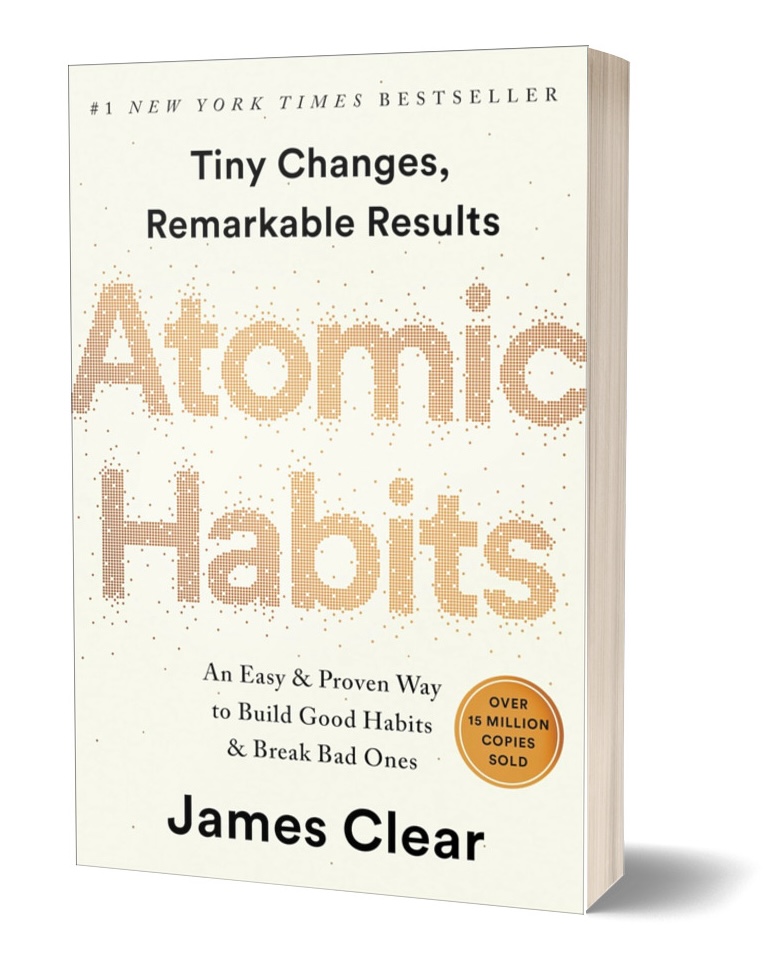Atomic Habits: An Easy & Proven Way to Build Good Habits & Break Bad Ones by James Clear
Summary and takeaways from the book.
Keywords:
Informed
Better life
Nov 18, 2023

The book helps us develop good habits and break bad ones.
The central message of the book is that several seemingly small incremental changes in our life can lead to big outcomes later; and achieving our goals is a result of engineering of our environment and lifestyle rather than motivation.

ISBN: 9780735211292
Published: October 16, 2018
Pages: 320
Available on:
amazon
The book helps us develop good habits and break bad ones.
The central message of the book is that:
several seemingly small incremental changes in our life can lead to big outcomes later.
achieving our goals is a result of engineering of our environment and lifestyle rather than motivation.
"
small improvements accumulate into such remarkable results".
The book has a positive and encouraging message. It shows us to
work with natural human behavior and make the best of it.
The author has several examples. One example is of the British cycling team. Multiple small changes help the team win after more than 100 years of just being a participant. "
a team of previously ordinary athletes transform into world champions with tiny changes that, at first glance, would seem to make a modest difference at best".
Outcomes are a lagging measure of your habits
"
Your net worth is a lagging measure of your financial habits.
Your weight is a lagging measure of your eating habits.
Your knowledge is a lagging measure of your learning habits.
Your clutter is a lagging measure of your cleaning habits.
You get what you repeat."
"
Are you spending less than you earn each month?
Are you making it into the gym each week?
Are you reading books and learning something new each day?
Tiny battles like these are the ones that will define your future self.
Time magnifies the margin between success and failure. It will multiply whatever you feed it. Good habits make time your ally. Bad habits make time your enemy."
"
one of the core reasons why it is so hard to build habits that last. People make a few small changes, fail to see a tangible result, and decide to stop. You think, “I’ve been running every day for a month, so why can’t I see any change in my body?”"
How to change
Let your identity drive your habits.
"
Research has shown that once a person believes in a particular aspect of their identity, they are more likely to act in alignment with that belief.
First, decide your identity: I am a daily gym person.
Second, decide the process: go to gym daily.
Third, decide the outcome: healthy.
Let your identity drive your habits.
Examples:
The goal is not to read a book, the goal is to become a reader.
Readers read.
The goal is not to run a marathon, the goal is to become a runner.
Runners run.
The goal is not to learn an instrument, the goal is to become a musician.
Musicians play.
"
Research has shown that once a person believes in a particular aspect of their identity, they are more likely to act in alignment with that belief."
"
Identity change is the North Star of habit change. "
Focus on getting better, not the goal
"
results had very little to do with the goals I set and nearly everything to do with the systems I followed."
"
If you want better results, then forget about setting goals. Focus on your system instead."
"
Goals are good for setting a direction, but systems are best for making progress."
"
problems arise when you spend too much time thinking about your goals and not enough time designing your systems."
"
Winners and losers have the same goals."
"
Ultimately, it is your commitment to the process that will determine your progress."
Motivation Is Overrated; Environment Often Matters More
Redesign your environment so it initiates good habits, and avoids temptations of bad habits.
E.g. fruit bowl always in prominent place, phone without social media, living close to park to make it easy to go for walk.
"
Environment is the invisible hand that shapes human behavior".
"
we are changed by the world around us".
"
Every habit is initiated by a cue, and we are more likely to notice cues that stand out".
Redesign your environment so it initiates good habits, and avoids temptations of bad habits. E.g. fruit bowl always in prominent place, phone without social media, living close to park to make it easy to go for walk.
"
By sprinkling triggers throughout your surroundings, you increase the odds that you’ll think about your habit throughout the day".
You only have to be motivated to change your environment occasionally(or even once). The redesigned environment triggers good habits all the time.
Summary
Motivation less important: "
our real motivation is to be lazy and to do what is convenient". Instead of fighting human behavior, we engineer around it. Instead of trying to get motivated, we engineer our environment and lifestyle to make it easy.
Self-control doesn't work, specially over long term. Don't rely on self-control or discipline or motivation.
Define your identity: who are you? Let your identity drive your habits.
Small changes are very important: Atomic habits more important than waiting for a big bang. Little changes compound over time.
Redesign of your environment most important. Motivation will be triggered by a well designed environment. "
One of the most effective ways to reduce the friction associated with your habits is to practice environment design".
Be your own 'choice architect'. Design your environment to help you make good choices.
Make it easy to follow good habit: Engineer your environment and lifestyle to make it easy to follow good habits. Doing the right thing should require least effort. E.g. if getting fit involves driving 10 minutes in traffic, you wont do it. Find an easier way to exercise at home. Instead of TV remote and TV in living room, make it a laptop or ipad in living room. Have home close to park so it is easy to go for walk or exercise outdoors. "
Every action requires a certain amount of energy. The more energy required, the less likely it is to occur."
Temptation bundling: make your good habit attractive by bundling it with what you enjoy doing. E.g. listen to what you like while exercising. Author has example of a person who connected exercise cycle to TV so he could only watch TV when exercising.
Humans are herd animals: "
We soak up the qualities and practices of those around us". Be with people with good habits.
Bad habits are response to some need. E.g. drinking tea when bored, anxiety and loneliness lead to reading news or social media addiction.
Repeat: "
Hebb’s Law: “Neurons that fire together wire together.”". "
Repeating a habit leads to clear physical changes in the brain." It is not time, but number of repetitions that lead to a good habit being formed. "
It’s the frequency that makes the difference."
Make new habit immediately satisfying, enjoyable and pleasurable: Author gives example of how better soap that people enjoy using improved sanitation. Key point here is immediate satisfaction, not delayed or abstract satisfaction. Doing something good should
immediately make you feel good.
Use habit tracker: use
visual measurement that is always visible to remind you all the time.
Accountability: have someone check on you.
"
Make Good Habits Inevitable and Bad Habits Impossible".
Engineer and redesign your environment and lifestyle. Little things add up.
Related articles
How to change the world
Are you busy?
External Links

